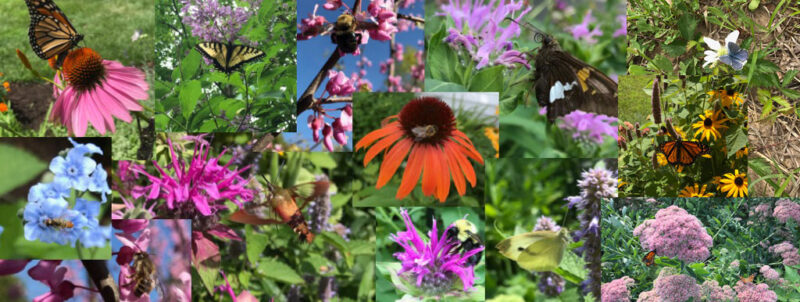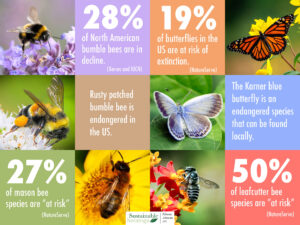Pollinators and Native Plants


Pollinators play an essential role in plant reproduction but their populations are under threat. Our Pollinator Committee is working to provide food and safe habitats for native pollinators.
Why are pollinators important?
Pollinators are essential to the reproduction of over 85% of the world’s flowering plants, including many of the foods we eat every day. While birds, bats and small mammals pollinate some plants, insects make up the largest group of pollinators. In New York State, our primary pollinators are insects like bees, flies, beetles, butterflies and moths. According to Pollinator.org, pollinator populations worldwide are facing severe threats to their survival that could, in turn, negatively impact natural communities and endanger our ability to produce food crops.
But pollinators benefit more than just humans. They are an essential part of the functioning of food webs around the world. Many plants need these pollinators to reproduce, and without that assistance, those plant species would decline or even disappear. The fruits and seeds that are formed after pollination happens are a major part of the diet of around twenty-five percent of all birds and mammals (chipmunks, bears, squirrels, voles, and more). Those little pollinators have a big role to play!
Who Are Our Pollinators?
We are dependent upon pollinators – but just who are these amazing creatures? While birds, bats and small mammals pollinate some plants, insects make up the largest group of pollinators. In New York State, our primary pollinators are insects like bees, flies, wasps, beetles, butterflies and moths.
Pollination is typically a mutually beneficial process. The plant pollen is delivered to the stigma, fertilizing the egg. The pollinator, in turn, receives some form of nutrition. Some plants are pollinated by lots of species (generalists), and some depend only on a single species or genus for pollination (specialists).
The Xerces Society provides a great overview of the six main groups of insect pollinators – solitary bees, bumble bees, butterflies & moths, wasps, flies, and beetles. Be sure to read our post Meet the Bumblebees.

READ MORE
Our friends at Saratoga Springs Public Library have put together a list of materials about pollinators: https://guides.sspl.org/pollinators
Where can you get locally grown native plants for your garden? Our annual Pollinator Palooza Native Plant Sale.
Have questions? Email us at pollinators@sustainablesaratoga.org




